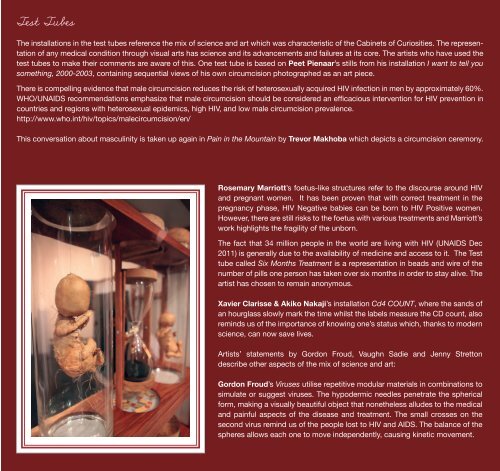View the A.R.T Show catalogue - KZNSA
View the A.R.T Show catalogue - KZNSA
View the A.R.T Show catalogue - KZNSA
You also want an ePaper? Increase the reach of your titles
YUMPU automatically turns print PDFs into web optimized ePapers that Google loves.
Test Tubes<br />
The installations in <strong>the</strong> test tubes reference <strong>the</strong> mix of science and art which was characteristic of <strong>the</strong> Cabinets of Curiosities. The representation<br />
of any medical condition through visual arts has science and its advancements and failures at its core. The artists who have used <strong>the</strong><br />
test tubes to make <strong>the</strong>ir comments are aware of this. One test tube is based on Peet Pienaar’s stills from his installation I want to tell you<br />
something, 2000-2003, containing sequential views of his own circumcision photographed as an art piece.<br />
There is compelling evidence that male circumcision reduces <strong>the</strong> risk of heterosexually acquired HIV infection in men by approximately 60%.<br />
WHO/UNAIDS recommendations emphasize that male circumcision should be considered an efficacious intervention for HIV prevention in<br />
countries and regions with heterosexual epidemics, high HIV, and low male circumcision prevalence.<br />
http://www.who.int/hiv/topics/malecircumcision/en/<br />
This conversation about masculinity is taken up again in Pain in <strong>the</strong> Mountain by Trevor Makhoba which depicts a circumcision ceremony.<br />
Rosemary Marriott’s foetus-like structures refer to <strong>the</strong> discourse around HIV<br />
and pregnant women. It has been proven that with correct treatment in <strong>the</strong><br />
pregnancy phase, HIV Negative babies can be born to HIV Positive women.<br />
However, <strong>the</strong>re are still risks to <strong>the</strong> foetus with various treatments and Marriott’s<br />
work highlights <strong>the</strong> fragility of <strong>the</strong> unborn.<br />
The fact that 34 million people in <strong>the</strong> world are living with HIV (UNAIDS Dec<br />
2011) is generally due to <strong>the</strong> availability of medicine and access to it. The Test<br />
tube called Six Months Treatment is a representation in beads and wire of <strong>the</strong><br />
number of pills one person has taken over six months in order to stay alive. The<br />
artist has chosen to remain anonymous.<br />
Xavier Clarisse & Akiko Nakaji’s installation Cd4 COUNT, where <strong>the</strong> sands of<br />
an hourglass slowly mark <strong>the</strong> time whilst <strong>the</strong> labels measure <strong>the</strong> CD count, also<br />
reminds us of <strong>the</strong> importance of knowing one’s status which, thanks to modern<br />
science, can now save lives.<br />
Artists’ statements by Gordon Froud, Vaughn Sadie and Jenny Stretton<br />
describe o<strong>the</strong>r aspects of <strong>the</strong> mix of science and art:<br />
Gordon Froud’s Viruses utilise repetitive modular materials in combinations to<br />
simulate or suggest viruses. The hypodermic needles penetrate <strong>the</strong> spherical<br />
form, making a visually beautiful object that none<strong>the</strong>less alludes to <strong>the</strong> medical<br />
and painful aspects of <strong>the</strong> disease and treatment. The small crosses on <strong>the</strong><br />
second virus remind us of <strong>the</strong> people lost to HIV and AIDS. The balance of <strong>the</strong><br />
spheres allows each one to move independently, causing kinetic movement.


